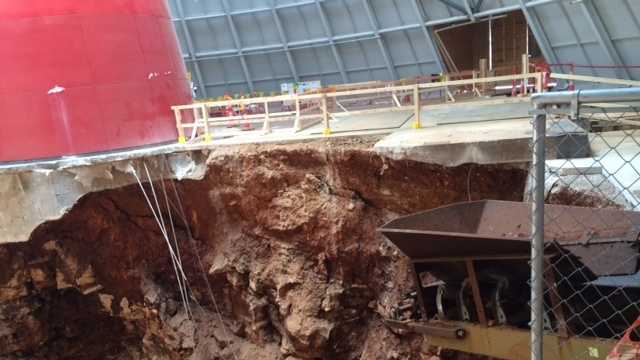Sinkholes cause big problems for many in Kentucky

When it comes to sinkholes, Kentucky ranks in the top 10 in the nation.
The most famous is the recent sinkhole at the National Corvette Museum in Bowling Green.
Images: Corvette museum sinkhole | Mobile video
WLKY found an expert who has been studying the phenomenon for more than four decades.
James Currens with the Kentucky Geological Survey said it can be predicted what areas of the commonwealth are most likely to have sinkholes, but there's no figuring exactly where and when one will open.
“We now have millions of people across the world that now know there's a Corvette museum in Bowling Green, Kentucky,” said Katie Frassinelli with the National Corvette Museum.
It is the most famous sinkhole in the commonwealth -- a monster that swallowed eight cars. But it's not the biggest.
According to the Kentucky Geological Survey, the largest also occurred in Bowling Green, when a roadway gave way in February of 2002.
"They happen very frequently here in Kentucky,” said Currens.
There are thousands across state. Most are small sinkholes like the ones found at Louisville's Eastern Cemetery. Each is tracked and mapped. Kentucky is ranked seventh in the nation in sinkholes. Florida is number one. A man lost his life near Tampa in March of last year.
It took two days to carefully remove debris to reveal the sinkhole that swallowed Jeff Bush.
Kentucky is one of the most famous karst areas in the world, which literally means "rocky ground."
“Between the limestone and the dolomite, about half the state is underlain by the soluble rock, said Currens.
Underground water sources eat away at the rock, creating a void and eventually leading to a collapse.
Last month, a senior living center in Hopkinsville was forced to evacuate after a sinkhole opened near the building.
One of the owners says they just kept seeing cracks along floors and walls.
“It seems like this section of the building is wanting to tear off and fall, you know, fall off,” said Mike Vaught, owner of Gainsville Manor.
Not all are as dramatic as the Hopkinsville or Bowling Green sinkholes. Many create depressions, like a large one outside the University of Kentucky library.
“UK is, of course, built on Lexington limestone, which is a formation that can form karst sinkholes and there are a lot in the area,” said Currens.
Sinkholes often become dumps, especially in rural areas, which doesn't help the situation.
“Either agriculture waste, household domestic waste, construction debris that's been buried in these features -- that rots and reactivates the sinkhole,” said Currens.
As for what happened to the National Corvette Museum, Currens says the skydome was built over an abandoned cave passage.
“The borings from the engineering studies did not detect the presence of that passage,” said Currens.
According to Currens’ observations, rain water from the museum was diverted away from the structure as it should have been. However, that caused clay, which acted as adhesive for the dome of the passage to dry out, leading to the collapse.
“It's a case where most things were done correctly and it still resulted in a collapse of major notoriety, I guess would be the word to use,” said Currens.
As for sinkhole insurance, it's unlikely your homeowners policy here in Kentucky will cover damage.
Following the incident National Corvette Museum, State Rep. Jody Richards of Bowling Green proposed legislation requiring more insurers to offer such coverage.
The bill never made it out of committee during this year's general assembly.
Click here for more information.

